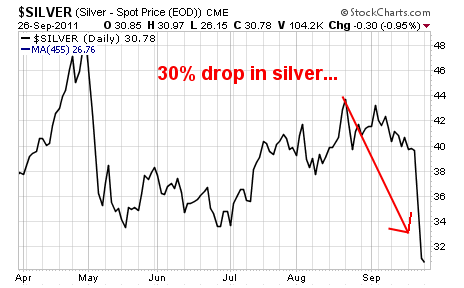In case you didn’t notice, silver dropped WAY more than gold recently.
While gold is currently about 15% off its highs of $1,900 – silver fell about 30% from peak to trough – in less than a month.

The bulk of the drop occurred in just the last week – from $40 down to below $30.
So what happened to precipitate such a dramatic fall?
Well, you might remember that a similar collapse occurred back in late April, early May.
And before I get into what caused both of these collapses, I do want to point out that these types of price swings are NOT rare at all for silver. It’s consistently the most erratic and volatile asset out there. That doesn’t mean it’s not a good long-term holding for commodity investors – it just means that it’s a rocky ride.
And basically that just means that silver is subject to a variety of catalysts that can have substantial short term price effects.
One of the biggest catalysts for ANY commodity or asset is a margin increase.
If you don’t know what margin is – it’s basically a way to buy (or sell) stocks or commodities with money borrowed from a broker. You post a small part of the purchase price, and you can control more shares or units. If the price rises, you can cash out for a much bigger profit. But if the trade goes against you, your broker can call your margin (a margin call) and possibly ask you to put up more capital to cover the loss.
So, it’s a great way to make or lose much more money than with regular buying and selling.
Each exchange has its own margin requirements – and the exchange can raise or lower these requirements in order to stimulate buying or selling.
That’s an oversimplification, but exchanges try to walk the line between creating lots of liquidity (by keeping margins low) and completely wiping out brokers and traders (by moving margins higher).
When an asset price rises too quickly, most exchanges will nip that asset in the bud with a margin requirement increase. Doing so tends to encourage selling – because when an asset rises quickly, it’s likely that most if not all of that asset’s buyers are already leveraged to the hilt. Asking them to post more margin basically forces them to sell.
I can’t speak to the more conspiratorial theories about which assets see their margin requirements raised – but gold and silver have both seen margins increase in the last year.
Back in late April, the Chicago Mercantile Exchange raised margin requirements by 16% on silver – that precipitated the huge selloff.
And this past week, something similar happened, which has HUGE ramifications for not just the precious metals market – but for every market.
Because silver margins were raised again.
But this time, it wasn’t in Chicago – or in any exchange in the U.S. – or even Europe.
This time, it was the Shanghai Gold Exchange that raised margins 20%.
So what does it mean?
For long term silver investors, it means another great entry point.
But the larger consequence is that the world’s center of power, influence, trade and influence are all shifting East – to China.
And that kind of move is huge. It’s a global shift that only happens about once every century, and more than any other indicator I’ve seen, I think this silver margin increase (and the corresponding drop in silver’s price) spells it out in big bold letters.
I hope you’re paying attention – this is history in the making.
Buy Gold for $400 an Ounce
Most gold miners are lucky to get their gold out of the ground for less than $1000 an ounce – which is great if gold is $1400 or more…But we found a specialized gold company that can buy gold for $400 an ounce. It’s a unique story – a safe way to benefit from high gold prices, with lots of downside protection. Click here for the full write-up.
 Facebook
Facebook
 Twitter
Twitter